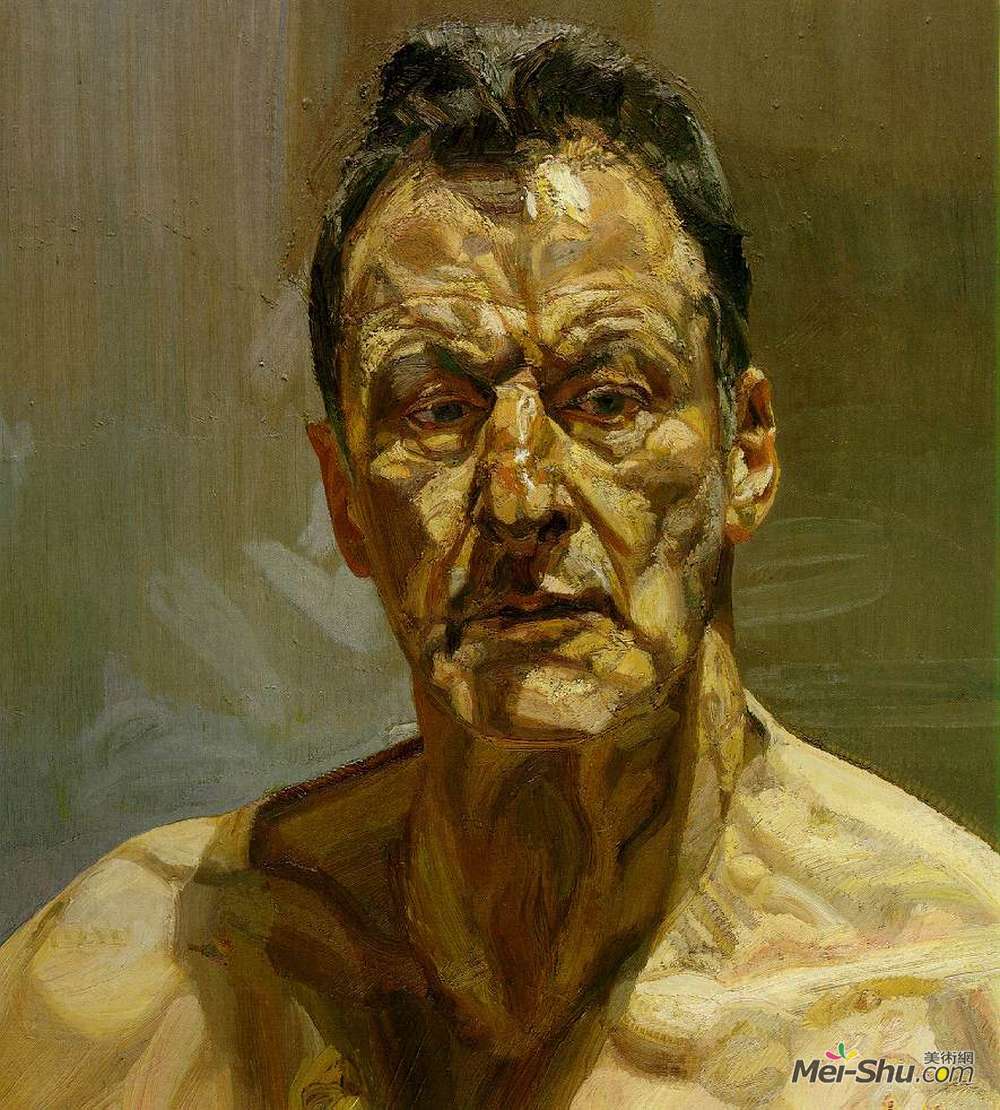
卢西安·弗洛伊德(Lucian Freud)
艺术家: 卢西安·弗洛伊德
生于: 1922年12月08日;德国柏林
卒于: 2011年7月20日;伦敦,英国
国籍: 英国
流派: 表现主义
领域: 绘画
受影响: 古斯塔夫·库尔贝,奥托·迪克斯,Alberto Giacometti,乔治·格罗茨,弗朗西斯·培根,New Objectivity (Neue Sachlichkeit)
影响: 艾瑞克·菲施尔,Damien Hirst,John Currin,School of London,Neo-Expressionism
朋友: 弗朗西斯·培根
机构: 加州大学斯莱德美术学院(伦敦大学学院),英国伦敦
卢西安·弗洛伊德是一位英国艺术家,以肖像画和自画像闻名于世,以一种富有表现力的新比喻风格。他出生于柏林,是革命心理学家西格蒙德·弗洛伊德的孙子,建筑师恩斯特·弗洛伊德和艺术历史学家露西·布拉希的儿子。
弗洛伊德在公众面前的表现与波希米亚艺术家的形象相对应。对所有当局来说,这很不合规矩,他在很小的时候就被一些学校开除了,后来,据说他的鲁莽行为是其中一所学校失火的原因。无论他和同伴一起去哪里,他都会注意到自己——在他的手腕或肩膀上有一只宠物鹰。弗洛伊德过去常花几天时间去吃饭,赌博,和英国贵族、社会名流和艺术家们呆在一起。他们当中有画家弗朗西斯·培根,他对弗洛伊德的作品影响很大,直到他们的友谊结束,这不可避免地要考虑到他们的性格和对彼此后来的作品缺乏尊重。具象绘画这一方法对当时被抽象主义支配的艺术世界极具争议。与那个学派的其他杰出画家戴维·霍克尼(David Hockney)或弗朗西斯·培根·弗洛伊德(Francis Bacon)相比,弗洛伊德(Freud)在风格上更传统。他画的人没有理想化,强调性特征和人体的缺陷。在他的绘画作品中,他常常描写特定个体,以及一般人的不安或不安的心理状态。
受20世纪早期表现主义的影响,弗洛伊德的宽阔、有纹理的笔触唤起了爱德华·芒奇和埃贡·席尔的艺术。他对椅子、鞋子等物品的拟人化描绘,以及他的倾斜视角,使我们想起了文森特·凡高的风格。到20世纪60年代末,佛洛伊德的笔触变得越来越重,层次越来越大。他的风格转变为可辨认的表达裸体肖像,代表变形和不愉快的身体。后来,在20世纪80年代和90年代,当弗洛伊德越来越受欢迎时,他画了许多著名的科目——艺术评论家
一旦他确立了他可识别的风格,直到他的艺术生涯结束,弗洛伊德才改变它。他与保姆的漫长而累人的会谈可以与他祖父的精神分析实践相比较。佛洛伊德挑战肖像画的传统,启发了新一代的画家,如约翰·柯林或Eric Fischl。
Artist :Lucian Freud
Additional Name :Lucian Michael Freud
Born : Berlin, Germany
Died : London, United Kingdom
Nationality :British
Art Movement :Expressionism
Influenced by :gustave-courbet,otto-dix,alberto-giacometti,george-grosz,francis-bacon,artists-by-art-movement/new-objectivity-neue-sachlichkeit
Influenced on :eric-fischl,damien-hirst,john-currin,artists-by-painting-school/school-of-london,artists-by-art-movement/neo-expressionism
Friends and Co-workers :francis-bacon
Art institution :UCL Slade School of Fine Art (University College London), London, UK
Lucian Freud was a British artist, famous for his portraits and self-portraits painted in an expressive neo-figurative style. He was born in Berlin, the grandson of the revolutionary psychologist Sigmund Freud, and thea son of an architect Ernst Freud and an art historian Lucie Brasch.
Freud’s representation in public was corresponding to the image of bohemian artist. Quite unruly to all the authorities, he was expelled from a few schools at an early age, and later on, his reckless behavior was said to be the cause of the fire in one of the schools. He drew
attention to himself wherever he went with his companion - a pet hawk on his wrist or shoulder. Freud used to spend days going to diners, gambling, and spending time in the company of the British aristocrats, socialites, and artists. Among them was the painter Francis Bacon, who was greatly affecting Freud’s work - until an end of their friendship, which was inevitable having in mind their characters and a lack of respect for each other’s later work.Freud belonged to the School of London, a group of artists dedicated to figurative painting. This approach was highly controversial to an art world which, at that time, was dominated by abstraction. Compared with other prominent painters of that school - David Hockney, or Francis Bacon - Freud was stylistically a more conventional artist. He painted people without idealizing them, emphasizing sexual characteristics and imperfections of a human body. In his paintings, he used to describe unease or somehow disturbed mental conditions of specific individuals, but also of humans in general.
Influenced by early 20th-century Expressionism, Freud’s wide, textured strokes evoke the art of Edvard Munch and Egon Schiele. His anthropomorphic depictions of objects such as chairs, shoes, etc., as well as his tilted perspective, reminds us of Vincent van Gogh’s style. By the end of 1960s, Freud’s strokes became heavier and more layered. His style changed towards recognizable expressive naked portraits, which represented deformed and unpleasant bodies. Later on, during the 1980s and 1990s, when he became increasingly popular, Freud made portraits of many famous subjects - an art critic
Once he established his recognizable style, Freud didn’t change it until the end of his artistic career. His long and tiring sessions with his sitters could be compared to the psychoanalytic practice of his grandfather. Freud challenged conventions of portraiture and inspired a new generations of painters, such as John Currin or Eric Fischl.